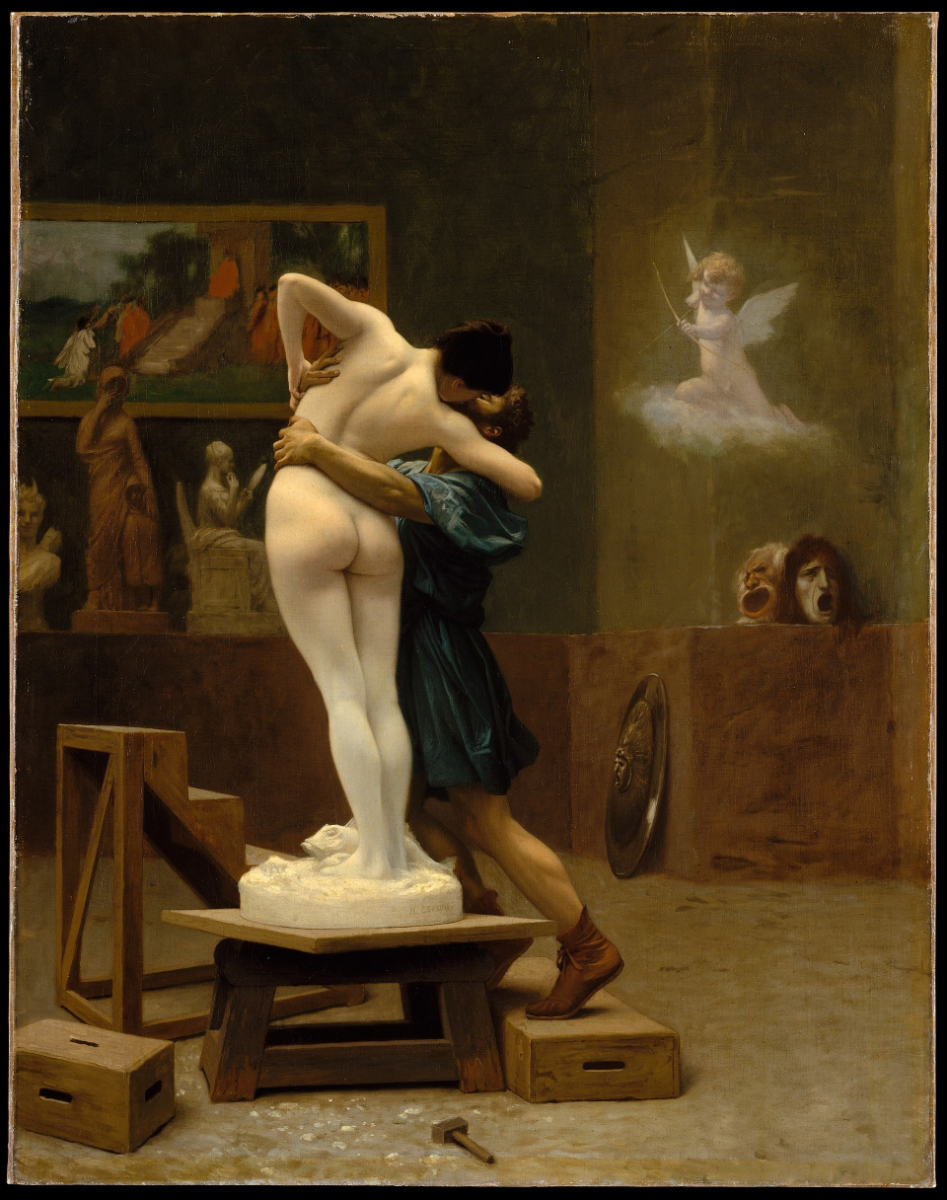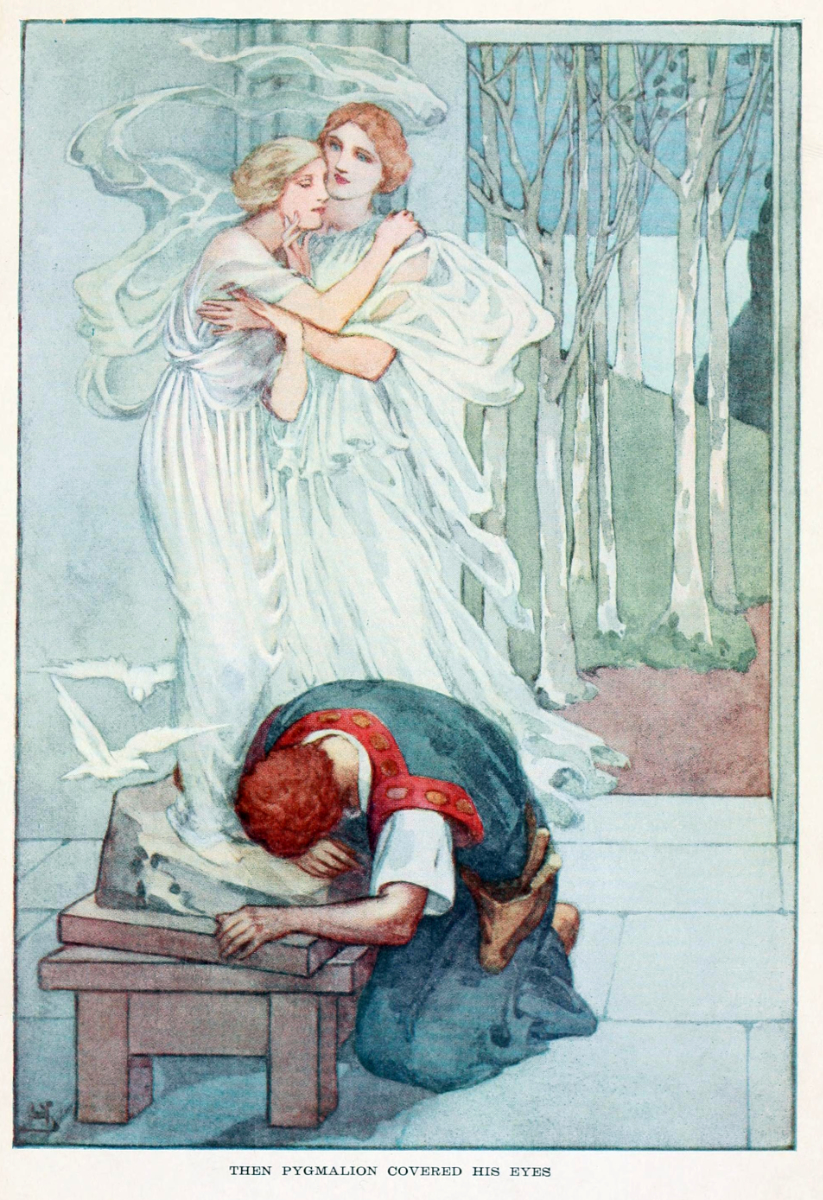In Greek mythology, Pygmalion was a legendary figure of Cyprus. In book 10 of Ovid’s Metamorphoses, Pygmalion was a Cypriot sculptor who carved a woman out of ivory alabaster. Post-classical sources name her Galatea. According to Ovid, when Pygmalion saw the Propoetides of Cyprus practicing prostitution, he began “detesting the faults beyond measure which nature has given to women”. He determined to remain celibate and to occupy himself with sculpting. He made a sculpture of a woman that he found so perfect he fell in love with it. Pygmalion kisses and fondles the sculpture, brings it various gifts, and creates a sumptuous bed for it. In time, Aphrodite’s festival day came and Pygmalion made offerings at the altar of Aphrodite. There, too afraid to admit his desire, he quietly wished for a bride who would be “the living likeness of my ivory girl”. When he returned home, he kissed his ivory statue, and found that its lips felt warm. He kissed it again, and found that the ivory had lost its hardness. Aphrodite had granted Pygmalion’s wish. Pygmalion married the ivory sculpture, which changed to a woman under Aphrodite’s blessing. The story of the breath of life in a statue has parallels in the examples of Daedalus, who used quicksilver to install a voice in his statues or to make them move; of Hephaestus, who created automata for his workshop; of Talos, an artificial man of bronze, and (according to Hesiod) of Pandora, who was made from clay at the behest of Zeus.
| Alias Pygmalion |
| Real Names/Alt Names Pygmalion |
| Characteristics Myths & Legends, Bronze Age |
| Creators/Key Contributors Ovid |
| First Appearance Greek mythology |
| First Publisher ○ |
| Appearance List Literature: Ovid’s Metamorphoses (8 CE). Many adaptations followed, including Frederick Tennyson’s “Pygmalion” from Daphne and Other Poems (1891) and George Bernard Shaw’s 1913 play Pygmalion. |
| Sample Read A Book of Myths (1915) by Jeanie Lang [Internet Archive] |
| Description In Greek mythology, Pygmalion was a legendary figure of Cyprus. In book 10 of Ovid’s Metamorphoses, Pygmalion was a Cypriot sculptor who carved a woman out of ivory alabaster. Post-classical sources name her Galatea. According to Ovid, when Pygmalion saw the Propoetides of Cyprus practicing prostitution, he began “detesting the faults beyond measure which nature has given to women”. He determined to remain celibate and to occupy himself with sculpting. He made a sculpture of a woman that he found so perfect he fell in love with it. Pygmalion kisses and fondles the sculpture, brings it various gifts, and creates a sumptuous bed for it. In time, Aphrodite’s festival day came and Pygmalion made offerings at the altar of Aphrodite. There, too afraid to admit his desire, he quietly wished for a bride who would be “the living likeness of my ivory girl”. When he returned home, he kissed his ivory statue, and found that its lips felt warm. He kissed it again, and found that the ivory had lost its hardness. Aphrodite had granted Pygmalion’s wish. Pygmalion married the ivory sculpture, which changed to a woman under Aphrodite’s blessing. The story of the breath of life in a statue has parallels in the examples of Daedalus, who used quicksilver to install a voice in his statues or to make them move; of Hephaestus, who created automata for his workshop; of Talos, an artificial man of bronze, and (according to Hesiod) of Pandora, who was made from clay at the behest of Zeus. |
| Source Pygmalion (mythology) – Wikipedia |


